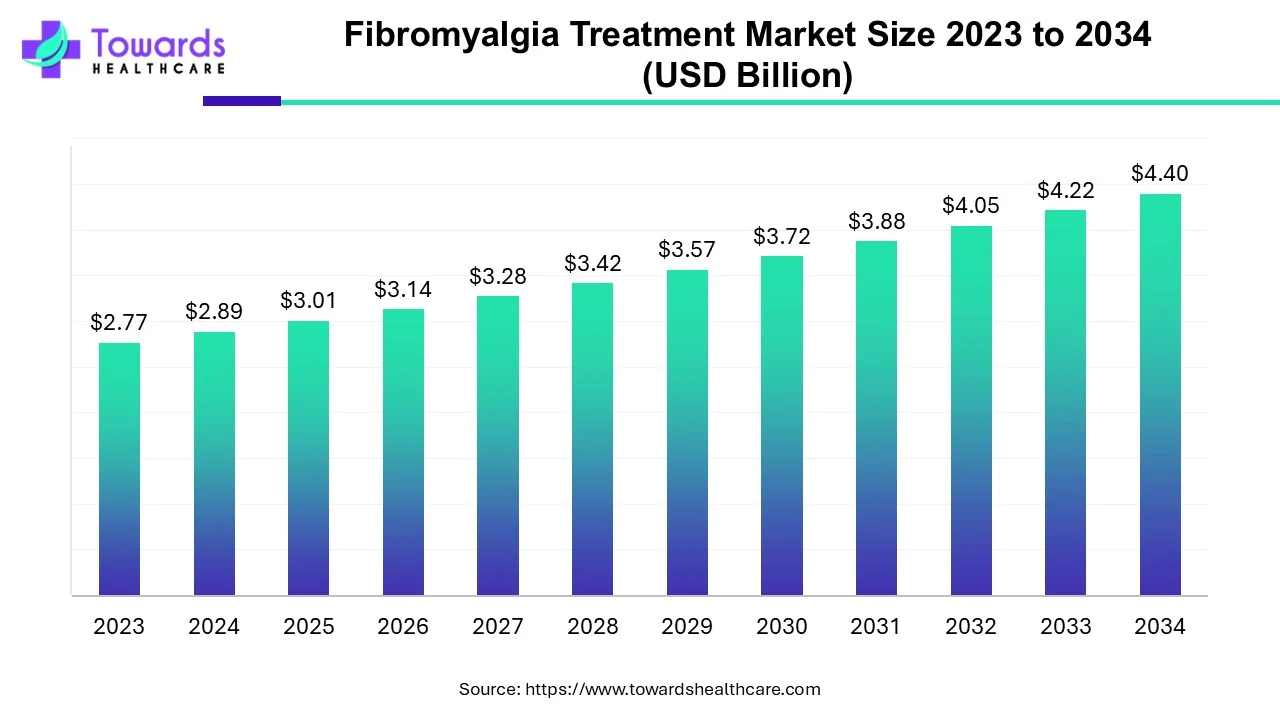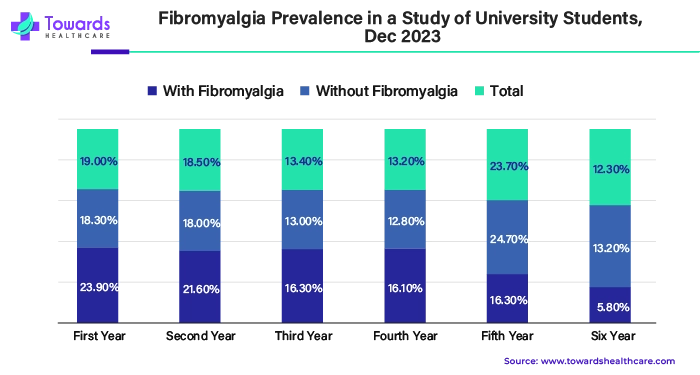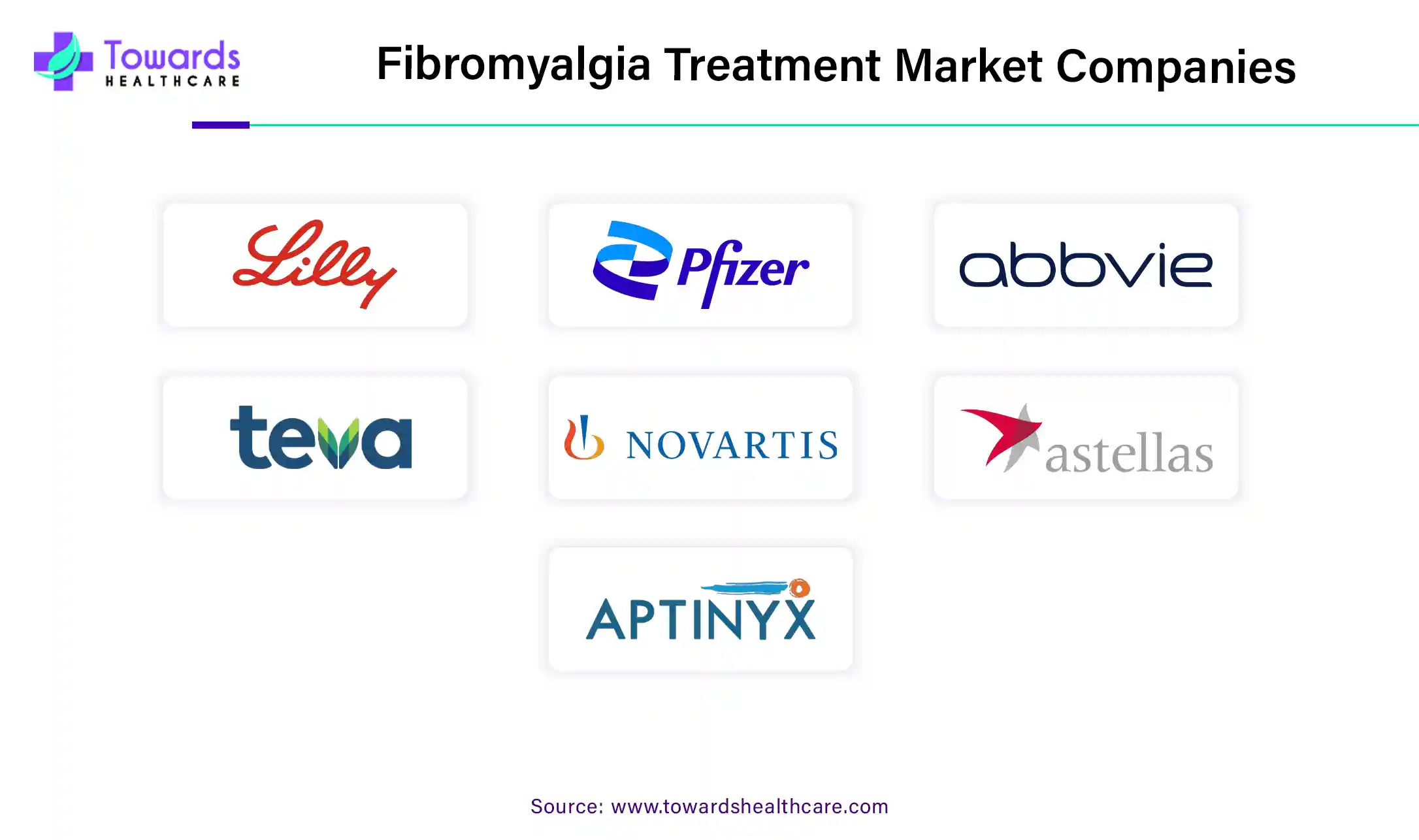January 2026

The fibromyalgia treatment market size is expected to grow from USD 3.01 billion in 2025 to USD 4.40 billion by 2034, with a CAGR of 4.3% throughout the forecast period from 2025 to 2034.

About 4 million adults in the United States, which is roughly 2% of the adult population, are impacted by fibromyalgia. While the exact cause of this condition remains unknown, effective treatment and management options are available. As the demand for treatment grows, researchers are venturing beyond traditional medications to explore innovative approaches for treating fibromyalgia.
Fibromyalgia is a condition where people have long-term muscle pain all over their body. They also often feel tired, have trouble thinking clearly, and may experience emotional and other physical symptoms. Doctors aren't sure what causes it or exactly how it works in the body. Even though people with fibromyalgia feel pain in their muscles and soft tissues, there's no sign of inflammation in those areas.
If someone already has a rheumatic disease, they have a higher chance of getting fibromyalgia. Doctors suggest using both non-drug treatments and medications for most fibromyalgia patients. Some people might find relief with non-drug treatments alone. Certain antidepressants and anticonvulsants have been shown to help with fibromyalgia pain. These include drugs like amitriptyline, duloxetine, and pregabalin. The US FDA has approved pregabalin, duloxetine, and milnacipran specifically for treating fibromyalgia. Therapy usually starts with antidepressants. If those don't work well, an anticonvulsant or another type of antidepressant may be tried. In more severe cases where fatigue, depression, or sleep problems are very bad, an anticonvulsant or a different antidepressant might be recommended.
Support programs and groups are available to help fibromyalgia patients find information and support to manage their health. New technology like mobile apps, wearable devices, and telemedicine is also changing how fibromyalgia is treated. These tools make it easier for patients to track their symptoms, talk to their doctors, and get treatment no matter where they are.
Governments around the world know it’s important to teach people about fibromyalgia, a kind of long-lasting pain that lots of folks have. They want to find it early and treat it fast to make life better for those who have it. They do this by talking about it in public, teaching people about it, and training doctors to recognize it. The government teams up with doctors and groups that help people with fibromyalgia to make sure everyone gets the support they need.
Fibromyalgia is a syndrome that affects more women than men. In the United States, about 6.4% of adults have fibromyalgia, with higher rates among women at 7.7% compared to men at 4.9%. To help people with fibromyalgia live better lives, it's important to find treatments that work for each person's unique symptoms. This might mean trying different medicines, therapies, or lifestyle changes. Scientists are working hard to understand what causes fibromyalgia and how to treat it better.
For instance,

Because fibromyalgia is becoming more common around the world, there's a greater need for treatments that can help manage its symptoms and make life easier for those with the condition. Doctors are realizing that not everyone with fibromyalgia responds to the same treatments. So, they're focusing on creating personalized plans for each patient.
Companies that make medications are investing in research to find new drugs that can help with fibromyalgia. They're also looking into using existing drugs in new ways to treat its symptoms. Alternative treatments like acupuncture, yoga, and meditation are becoming more popular for fibromyalgia because they can help people feel better.
As people understand fibromyalgia better, there's less stigma around it, and more people are seeking help for their symptoms. Support groups and programs are popping up to help people with fibromyalgia learn about their condition and find the right treatments.
Doctors, researchers, and drug companies are working together to come up with new ways to help people with fibromyalgia feel better. There's a lot of progress happening in treating fibromyalgia. More people are learning about it, and doctors are finding better ways to help those who have it.
When Scientists find new ways to help people with fibromyalgia feel better, it means more options for patients and doctors. These treatments can include things like new medications, different kinds of therapy, or even lifestyle changes. As more options become available, more people might seek help for their fibromyalgia symptoms, leading to a bigger market for the treatment.
For instance,
When there are new treatments, it often means better outcomes for patients, which can encourage even more people to seek help. This creates a cycle where fibromyalgia treatments keep growing as researchers continue to find new ways to help those affected by the condition.
Emerging treatments for fibromyalgia prioritize easing symptoms and enhancing patients' well-being. Certain complementary and alternative medicine (CAM) approaches have demonstrated potential in this regard.
Misdiagnosis happens when doctors mistake one condition for another. With fibromyalgia, this can be a big problem because of this, many people with fibromyalgia don’t get the right diagnosis at 1st. they might go through a long process of trying different treatments for conditions they don’t have, which can be frustrating and tiring.
For instance,
Almost 40% of the 1,000 respondents in the UK survey were unaware of fibromyalgia, and another 23% were unsure if they knew what it was. This is in line with the rising number of searches for the condition over time.

This delay in getting the right diagnosis can mean a delay in starting the right treatment. Meanwhile, the person with fibromyalgia is dealing with ongoing symptoms and might not get the support they need. It can also lead to unnecessary tests, doctor visits, and medications, which can be expensive and time-consuming.
Misdiagnosis can take an emotional toll on patients. They might feel frustrated, confused, or even start to doubt themselves because they are not getting better despite trying different treatments. This can affect their mental health and overall well-being. Healthcare providers need to know the usual signs of fibromyalgia and think about it as a possible diagnosis, especially if other conditions have been ruled out or if symptoms keep going even with treatment. Teaching people and spreading awareness about fibromyalgia through campaigns can also help stop misdiagnosis by telling both healthcare workers and the public about what fibromyalgia is and how it's different from other illnesses.
In North America, the landscape for fibromyalgia treatment varies depending on where you are. In metro cities, there are usually more options for treatment, like specialized doctors and clinics that focus on conditions like fibromyalgia. These places often have access to the latest treatments and therapies. Another thing to consider is insurance coverage. In some places, insurance might cover certain treatments for fibromyalgia, while in others, it might not. This can affect people's ability to afford treatment and access the care they need. while North America generally has a good healthcare system with many resources available, the geographical landscape can still impact how easily people can access fibromyalgia treatment. Healthcare providers and policymakers need to consider these factors when trying to improve care for people with fibromyalgia across different regions.
In various countries across the Asia Pacific region, attitudes and beliefs about chronic pain conditions such as fibromyalgia may differ. Some cultures may hold stigmatized views towards chronic illnesses, impacting how healthcare providers and society perceive and treat fibromyalgia patients. In places like Japan and South Korea, where healthcare is advanced, people with fibromyalgia can easily see doctors, get tests done, and choose from different treatments like medicines and therapies. In these countries, more doctors and people know about fibromyalgia, which can lead to better care and results for patients. In developing areas of the Asia Pacific region, getting specialized care for fibromyalgia can be hard. Patients might struggle to reach healthcare facilities, get diagnosed quickly, or find the right treatments.
In the market for treating fibromyalgia, many companies are competing to offer solutions. These include medications, therapies, and other products aimed at easing symptoms and improving patients' lives. Each company tries to stand out by offering effective treatments and addressing the specific needs of fibromyalgia patients. As more companies enter the market, there's a greater variety of options available to patients, leading to increased competition and innovation in the field.

By Treatment Type
By Distribution Channel
By Region
January 2026
December 2025
December 2025
December 2025